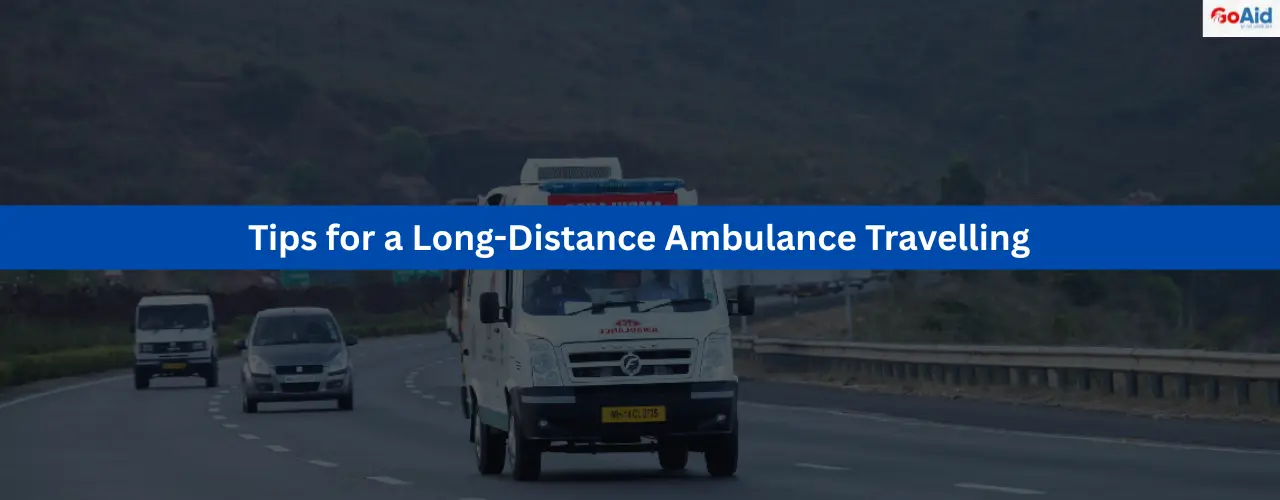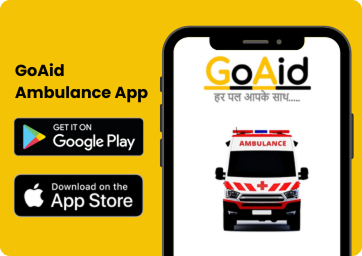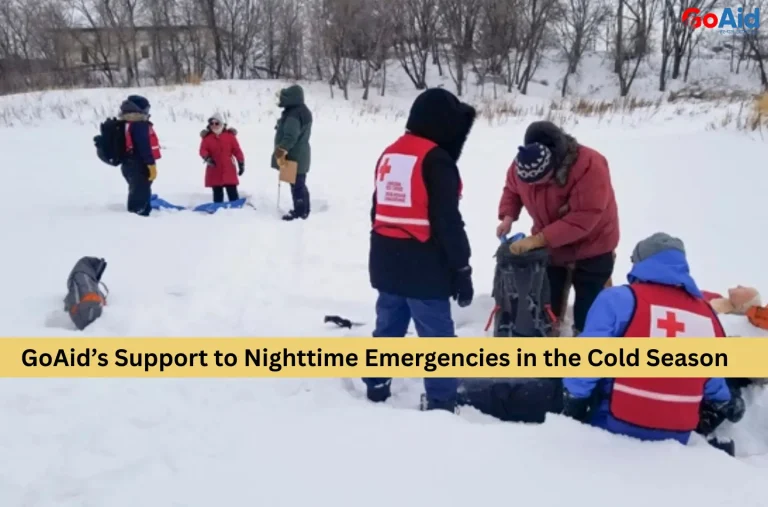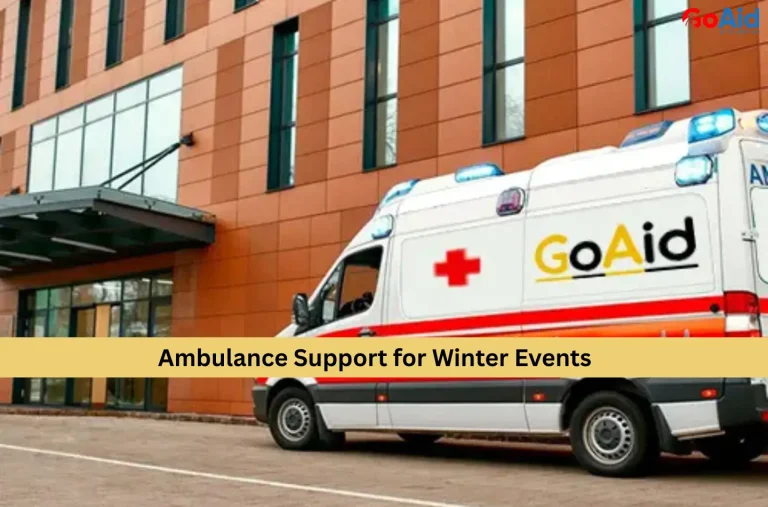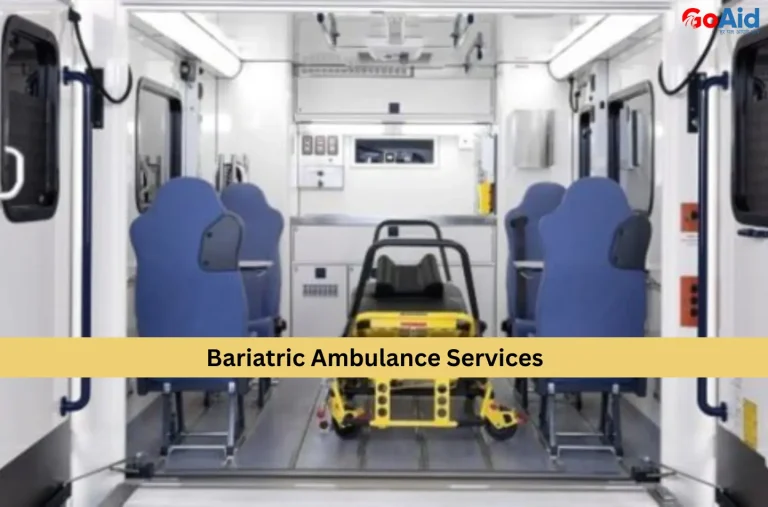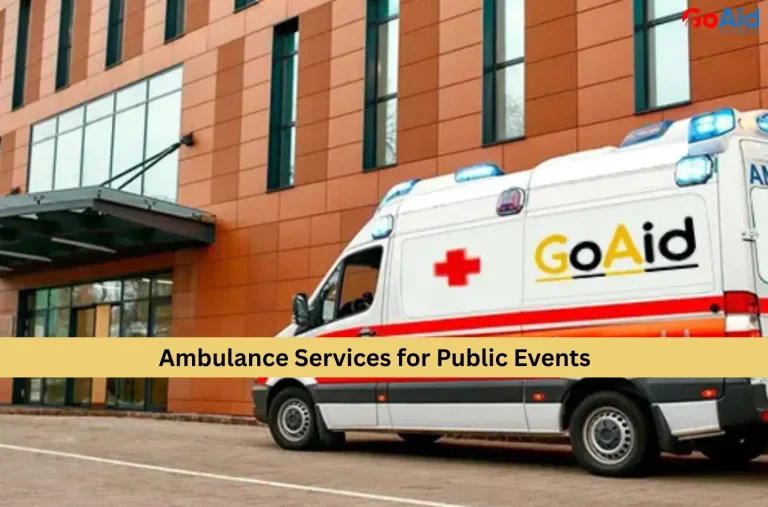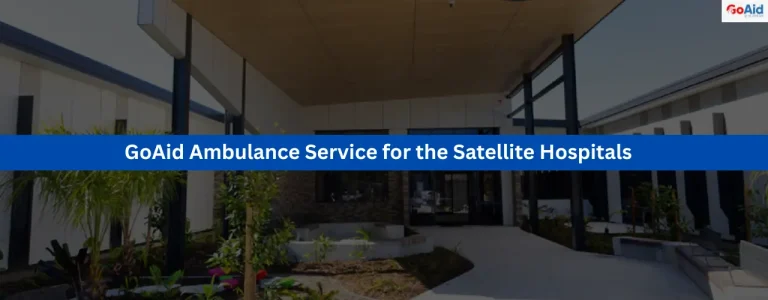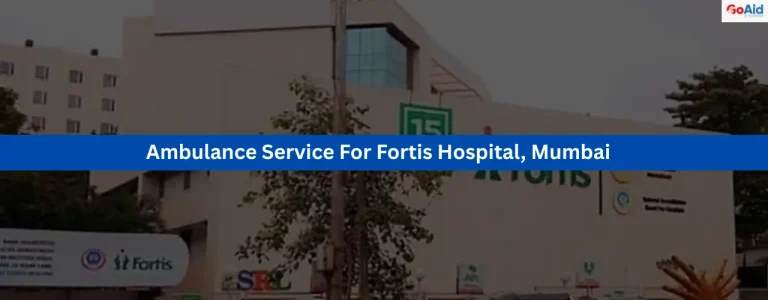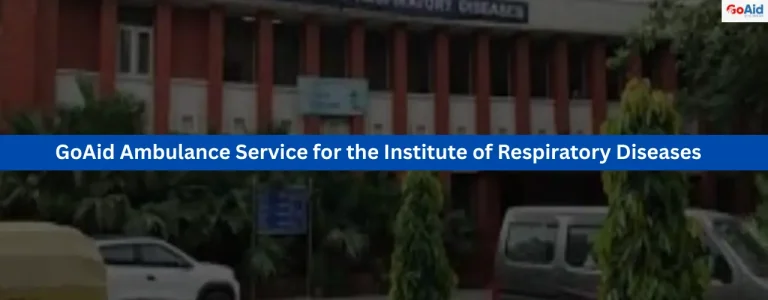If you or your loved one is being shifted through a long-distance ambulance service, then it’s important to know that the journey isn’t like a quick hospital visit. These medical transfers often take several hours, or even longer, and require advance planning. Unlike local transfers, long-route ambulance journeys demand a proper ambulance traveling checklist to ensure patient comfort, medical safety, and peace of mind.
In this blog, weŌĆÖve created a practical and easy-to-follow GoAid ambulance travel guide covering everything you need, from medical records to comfort items. Want to be fully prepared for your ambulance travel? Read till the end.
So, letŌĆÖs begin,
Why Do We Need to Prepare for Long-Distance Ambulance Transfer?
Preparing for a long-distance ambulance service is essential because these journeys are time-consuming and involve continuous medical supervision. Unlike local transfers, long-route shifts demand additional support, both emotionally and physically, for the patient and their caretakers. Every small item, from medical records to essential supplies, can make a significant difference.
Often, families overlook the practical challenges of such journeys, including sudden weather changes, road conditions, or medication needs. Proper planning ensures that the patient receives uninterrupted care throughout the journey.
Additionally, a well-prepared ambulance traveling checklist prevents stress and delays during emergencies. With a bit of foresight, you can make the journey safer, smoother, and more comfortable. ThatŌĆÖs why GoAid Ambulance Travel Guide always recommends advance preparation.
Different Types of Long-Distance Medical Transport
There are multiple types of long-distance ambulance options depending on the patient’s condition, urgency, and budget. Here are the most commonly used ones:
1. Road Ambulance (Normal)
This is the most common form of long-distance ambulance service used for non-critical patients. ItŌĆÖs suitable for transfers between hospitals or home to hospital over intercity routes. Patients stable enough to travel sitting or lying down can use this affordable option.
2. BLS (Basic Life Support) Ambulance
A BLS ambulance is ideal for patients who need oxygen support, basic medical monitoring, or post-surgery observation. It is commonly used for seniors, stable patients, or those with respiratory issues traveling across cities under supervision.
3. ALS (Advanced Life Support) Ambulance
ALS ambulances are equipped with ICU-grade support and advanced equipment. They are used for patients in serious condition, including those on a ventilator or requiring continuous medical assistance during the transfer. Trained paramedics are always present.
Also Read: Difference between BLS Ambulance and ALS Ambulance
4. Air Ambulance
An air ambulance is used for time-sensitive or critical transfers between distant cities or states. ItŌĆÖs suitable for patients who require rapid travel due to limited time or severe health deterioration. ICU setup and medical crew are included.
5. Train Ambulance
This type is used for long journeys where the patient is stable but needs to be transported safely and affordably over 500ŌĆō1000 km distances. It includes medical escorts, stretcher arrangements, and onboard support throughout the journey.
6. Dead Body Ambulance with Freezer Box
For deceased individuals, dead body ambulances with freezer boxes are used to preserve the body during long-distance transport. These are typically used when the body needs to be returned to the home city or native place for last rites.
The List of Patient Transfer Essentials
During long-distance ambulance travel, itŌĆÖs important to carry all necessary medical and support items for the patient. These essentials ensure safe, uninterrupted care during the journey. HereŌĆÖs what should never be missed:
1. Valid Medical Records
Carry all recent prescriptions, discharge summaries, lab reports, and doctorŌĆÖs notes to help onboard medical staff understand the patient’s history.
2. DoctorŌĆÖs Fitness Certificate
A document from the consulting doctor stating the patient is fit for transport helps ensure safety and avoid complications.
3. Ongoing Medications
Pack all prescribed medicines, including emergency ones. Include dosage instructions for the onboard staff and caregivers.
4. Medical Equipment (if needed)
Portable items like nebulizers, insulin pens, or feeding tubes should be packed based on the patientŌĆÖs condition.
5. Oxygen Cylinder/Support Kit
If required, coordinate in advance for oxygen support, especially for patients with respiratory conditions.
6. Health Insurance Documents
These might be needed in case of hospitalization at the destination. Always carry a copy.
7. Identification Proof
Valid ID of the patient is essential during interstate travel or at hospital checkpoints.
8. Blankets or Positioning Pillows
Soft support items help reduce discomfort during long road or rail journeys.
The List of Personal Care Items
Comfort during a long-distance ambulance service matters, especially for patients who are fragile or recovering. These ambulance traveling tips highlight personal care essentials to improve comfort:
1. Tissues and Wet Wipes
For maintaining hygiene and cleaning hands or face during the journey.
2. Water Bottle
Staying hydrated is important, especially for non-critical patients or caretakers.
3. Lip Balm or Moisturizer
Helps combat dryness from long AC journeys, especially in air ambulances or winter travel.
4. Adult Diapers (if needed)
Important for elderly or bedridden patients with incontinence concerns.
5. Sanitizer
Crucial for hand hygiene, especially when you’re touching support rails or medications.
6. Mouth Mask
Helps prevent infection and keeps air clean during transport.
7. Socks and Comfortable Clothing
Keeps the patient warm and reduces travel fatigue.
8. Disinfectant Spray
Useful for cleaning patient surroundings during longer halts or train transfers.
9. Small Travel Pillow
Improves head and neck support on bumpy roads.
10. Towel or Napkin
For wiping sweat or managing spills quickly during the trip.
11. Eye Mask or Earplugs
For patients who need to sleep or are sensitive to light and noise.
Packing for Family Members Accompanying the Patient
When a family member travels along with the patient during a long-distance ambulance service, their preparation is equally important. Unlike regular travel, this journey involves continuous alertness and emotional responsibility.
Caregivers must carry their own ID proof, a phone with full charge, power bank, and important contact numbers. If the travel time is long, it’s advisable to pack light snacks, drinking water, and basic medicines for themselves as well. This helps avoid fatigue and maintain focus on the patientŌĆÖs needs.
Comfortable clothing, footwear, and hygiene items like tissues or sanitizer also help reduce travel stress. DonŌĆÖt forget extra cash or a payment card, in case of tolls, fuel stops, or emergency purchases.
Lastly, staying mentally prepared is just as essential. Long-distance transfers can be exhausting, and the presence of a calm, supportive caregiver ensures the patient feels secure and looked after throughout the journey.
Other Key Tools to Carry
Beyond medical and personal care essentials, certain tools are vital during long-distance ambulance transfers. These help manage unexpected issues and improve comfort, communication, or coordination during travel.
1. Mobile Phone & Charger
Always carry a fully charged phone and charger to stay connected with hospitals, ambulance staff, or family members, especially during cross-state or late-night transfers.
2. Power Bank
For uninterrupted access to calls, updates, or maps, a power bank is critical when traveling long hours where charging points might not be available.
3. Notebook and Pen
Useful for noting down instructions from paramedics, hospital details, toll receipts, or emergency phone numbers during transit.
4. Small Torch or Flashlight
In case of low lighting during nighttime stops or power failure inside the vehicle, a portable light ensures convenience and safety.
5. Plastic Bags for Waste Disposal
Help manage used tissues, wrappers, or disposable items without compromising hygiene inside the ambulance cabin.
6. Trolley or Easy-Carry Bag
A single compact bag helps you keep all essentials organized and easy to shift, especially in case of hospital-to-hospital transfers.
7. Pain Relievers or Motion Sickness Tablets
Especially for family members or patients who are prone to discomfort due to road or train vibrations.
8. Important Contact List (Hard Copy)
In case your phone is inaccessible, carry written contact details of doctors, hospitals, and emergency responders.
Emergency Items Checklist
Emergencies can happen even during transport. This checklist ensures youŌĆÖre ready with the necessary tools and resources to handle any unexpected health or logistical challenges on the go.
1. Basic First Aid Kit
Includes bandages, antiseptic cream, gauze, and gloves to manage minor issues quickly during the journey.
2. Glucose or Energy Powder
Essential for diabetic or weak patients. A quick glucose dose can prevent fainting or energy crashes en route.
3. Emergency Contact Card
Keep a laminated card with the patientŌĆÖs name, emergency contact, blood group, and known allergies in an easy-to-access place.
4. Spare Prescribed Medicines
Carry at least one extra dose of all prescribed medications in case the journey gets delayed or extended.
5. Thermometer
Helpful for monitoring patient temperature during long-distance trips, especially for fever-prone or recovering individuals.
6. Pulse Oximeter
Vital for patients with respiratory issues or post-COVID recovery to track oxygen saturation throughout the trip.
7. BP Monitor (if needed)
For cardiac or elderly patients, checking blood pressure regularly is critical, especially on long routes.
8. Ice Pack or Warm Pack
Use depending on the patient’s pain management needs, especially useful for injury-related transfers.
9. Medical Gloves & Sanitizer
Essential for hygiene and safety during sudden patient care situations or handling body fluids.
10. Extra Face Masks
Always keep backup surgical masks for both patient and caregiver to prevent airborne infections or exposure.
Tips for Stress-Free Intercity Ambulance Travel
Long-distance ambulance travel can be overwhelming for both patients and caregivers. These simple but effective tips can help ensure a smoother, safer, and more comfortable experience throughout the entire intercity medical transfer.
1. Plan in Advance
Make all arrangements a day ahead, ambulance booking, documents, and caregiver essentials. This minimizes last-minute stress and allows the medical team to prepare according to the patient’s condition.
2. Confirm All Medical Requirements
Inform the ambulance provider of specific needs, oxygen, ventilator, or IV support. Ensuring all medical equipment is pre-arranged avoids complications during the journey.
3. Pack Light but Smart
Bring only essential documents, medicines, and comfort items. Overpacking can clutter the space and restrict movement inside the ambulance.
4. Stay in Constant Communication
Keep your phone handy and stay in touch with the receiving hospital. It helps in smooth handovers and reduces waiting time upon arrival.
5. Carry Emergency Contacts in Hard Copy
In case your phone runs out of charge or network, having important numbers written down ensures you’re never disconnected from help or information.
6. Dress the Patient Comfortably
Ensure the patient is dressed in breathable, non-restrictive clothes suitable for their condition and the weather. This adds comfort throughout the trip.
7. Keep a First Aid Pouch Handy
Apart from the onboard medical kit, having personal first aid items close by gives added assurance in case of minor emergencies.
8. Assign a Calm Caregiver
Choose someone emotionally steady and physically alert to accompany the patient. They act as a vital support system during unexpected issues.
9. Track Route & Weather
Check for weather updates and traffic congestion before departure. It helps anticipate delays and plan necessary breaks accordingly.
10. Trust a Reliable Ambulance Provider
Go with a trusted service like GoAid for assured safety, proper medical arrangements, and prompt support, especially for long-distance ambulance service across cities.
Conclusion to the Tips for a Long-Distance Ambulance Travelling
In conclusion, weŌĆÖve shared a complete guide on how to prepare for a long-distance ambulance service, what essentials to pack, and the importance of being medically and mentally ready. It doesnŌĆÖt matter if itŌĆÖs medical records, personal care items, or tools for caregivers, each item has its own role in making the trip smoother and safer.
If you are following this ambulance traveling checklist, then it can reduce your stress, improve coordination, and ensure better care throughout the journey. Trusting a reliable service like GoAid Ambulance Travel Guide makes all the difference during these intercity or interstate patient transfers. Plan ahead, and travel with peace of mind.
FAQs
Question-1: What is considered a long-distance ambulance service?
Answer: A long-distance ambulance service involves intercity or interstate medical transport, usually spanning over 100+ kilometers, and requires medical equipment and trained staff for patient safety during extended travel.
Question-2: What should I pack for a long ambulance journey?
Answer: Follow a detailed ambulance traveling checklist including medical reports, medications, ID proofs, oxygen support items, personal hygiene tools, and emergency contact details to ensure preparedness during the journey.
Question-3: Is a caregiver allowed during a long-distance ambulance transfer?
Answer: Yes, most ambulance in Mumbai and intercity services allow one family member to accompany the patient. ItŌĆÖs essential that the caregiver is calm and well-prepared.
Question-4: Can I book a long-distance ambulance in advance?
Answer: Absolutely. Medical transport preparation should start early. GoAid allows pre-scheduled booking with route planning, medical setups, and documentation ready before departure.
Question-5: Does GoAid provide air ambulance for long routes?
Answer: Yes, GoAid Ambulance Service in Mumbai provides air ambulance options for critical or time-sensitive long-distance medical transfers across Indian cities and states.
Question-6: What kind of medical staff travels in a long-distance ambulance?
Answer: Depending on the patient’s condition, GoAid assigns trained paramedics, nurses, or even doctors in ALS or ICU ambulances. This ensures safety throughout the journey.
Question-7: How much does long-distance ambulance travel cost?
Answer: The cost varies based on distance, ambulance type (Normal, BLS, ALS), and services needed. Ambulance traveling tips suggest comparing rates and checking for hidden charges before booking.
Question-8: What documents are required during ambulance transfer?
Answer: Essential documents include the patientŌĆÖs ID, recent prescriptions, discharge summaries, hospital references, and a fitness certificate. Always carry a hard copy for interstate transfers.
Question-9: Can I travel overnight in an ambulance?
Answer: Yes. GoAid’s long-distance ambulance service operates 24/7, including overnight routes. Proper arrangements like lighting, rest intervals, and monitoring are ensured throughout.
Question-10: What if there is a delay or medical emergency during transit?
Answer: GoAid Ambulance Travel Guide includes contingency plans, backup routes, and trained staff to manage emergencies during travel. You’re never alone during the journey.

